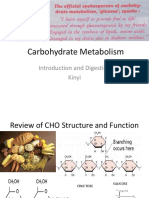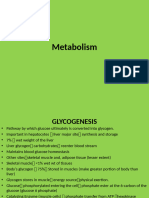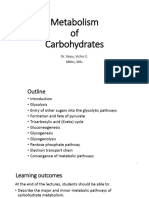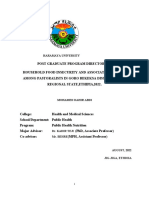0 ratings0% found this document useful (0 votes)
2 viewsGlycolysis
Glycolysis
Uploaded by
Sourav DasCopyright:
© All Rights Reserved
Available Formats
Download as PDF, TXT or read online from Scribd
Glycolysis
Glycolysis
Uploaded by
Sourav Das0 ratings0% found this document useful (0 votes)
2 views17 pagesCopyright
© © All Rights Reserved
Available Formats
PDF, TXT or read online from Scribd
Share this document
Did you find this document useful?
Is this content inappropriate?
Copyright:
© All Rights Reserved
Available Formats
Download as PDF, TXT or read online from Scribd
Download as pdf or txt
0 ratings0% found this document useful (0 votes)
2 views17 pagesGlycolysis
Glycolysis
Uploaded by
Sourav DasCopyright:
© All Rights Reserved
Available Formats
Download as PDF, TXT or read online from Scribd
Download as pdf or txt
You are on page 1of 17
Glycolysis
• Glucose is the body’s most readily available source of energy.
• After digestive processes break polysaccharides down into monosaccharides,
including glucose, the monosaccharides are transported across the wall of the small
intestine and into the circulatory system, which transports them to the liver.
• In the liver, hepatocytes either pass the glucose on through the circulatory system or
store excess glucose as glycogen.
• Cells in the body take up the circulating glucose in response to insulin and, through a
series of reactions called glycolysis, transfer some of the energy in glucose to ADP to
form ATP .
• The last step in glycolysis produces the product pyruvate.
• Glucose + 2ATP + 2NAD + 4ADP + 2P → Pyruvate + 4ATP + 2N
• One glucose molecule breaks down into two pyruvate molecules, and creates two
net ATP molecules and two NADH molecules by glycolysis.
• Therefore, glycolysis generates energy for the cell and creates pyruvate molecules
that can be processed further through the aerobic Krebs cycle (also called the citric
acid cycle or tricarboxylic acid cycle); converted into lactic acid or alcohol (in
yeast) by fermentation; or used later for the synthesis of glucose through
gluconeogenesis.
• Glycolysis include the enzymes responsible for the reactions.
• When glucose enters a cell, the enzyme hexokinase (or glucokinase, in the liver)
rapidly adds a phosphate to convert it into glucose-6-phosphate.
• A kinase is a type of enzyme that adds a phosphate molecule to a substrate (in this
case, glucose, but it can be true of other molecules also).
• This conversion step requires one ATP and essentially traps the glucose in the cell,
preventing it from passing back through the plasma membrane, thus allowing
glycolysis to proceed.
• It also functions to maintain a concentration gradient with higher glucose levels in the
blood than in the tissues.
• By establishing this concentration gradient, the glucose in the blood will be able to
¼ow from an area of high concentration (the blood) into an area of low concentration
(the tissues) to be either used or stored.
• Hexokinase is found in nearly every tissue in the body.
• Glucokinase, on the other hand, is expressed in tissues that are active when blood glucose
levels are high, such as the liver.
• Hexokinase has a higher a¾nity for glucose than glucokinase and therefore is able to
convert glucose at a faster rate than glucokinase.
• This is important when levels of glucose are very low in the body, as it allows glucose to
travel preferentially to those tissues that require it more.
• the enzyme glucose-6- phosphate isomerase converts glucose-6-phosphate into fructose-6-
phosphate. Like glucose, fructose is also a six carbon-containing sugar.
• The enzyme phosphofructokinase-1 then adds one more phosphate to convert fructose-6-
phosphate into fructose-1-6-bisphosphate, another six-carbon sugar, using another ATP
molecule.
• Aldolase then breaks down this fructose-1-6-bisphosphate into two three-carbon
molecules, glyceraldehyde-3-phosphate and dihydroxyacetone phosphate.
• The triosephosphate isomerase enzyme then converts dihydroxyacetone phosphate into
a second glyceraldehyde-3-phosphate molecule.
• Therefore, by the end of this chemical- priming or energy-consuming phase, one
glucose molecule is broken down into two glyceraldehyde-3- phosphate molecules.
• The second phase of glycolysis, the energy-yielding phase, creates the energy that is
the product of glycolysis.
• Glyceraldehyde-3-phosphate dehydrogenase converts each three-carbon
glyceraldehyde-3- phosphate produced during the energy-consuming phase into 1,3-
bisphosphoglycerate.
• This reaction releases an electron that is then picked up by NAD+ to create an NADH
molecule.
• NADH is a high-energy molecule, like ATP, but unlike ATP, it is not used as energy
currency by the cell.
• Because there are two glyceraldehyde-3-phosphate molecules, two NADH
molecules are synthesized during this step.
• Each 1,3-bisphosphoglycerate is subsequently dephosphorylated (i.e., a
phosphate is removed) by phosphoglycerate kinase into 3-phosphoglycerate.
• Each phosphate released in this reaction can convert one molecule of ADP into
one highenergy ATP molecule, resulting in a gain of two ATP molecules.
• The enzyme phosphoglycerate mutase then converts the 3- phosphoglycerate
molecules into 2-phosphoglycerate.
• The enolase enzyme then acts upon the 2-phosphoglycerate molecules to
convert them into phosphoenolpyruvate molecules.
• The last step of glycolysis involves the dephosphorylation of the two
phosphoenolpyruvate molecules by pyruvate kinase to create two pyruvate
molecules and two ATP molecules.
Anaerobic Respiration
• When oxygen is limited or absent, pyruvate enters an anaerobic pathway.
• In these reactions, pyruvate can be converted into lactic acid.
• In addition to generating an additional ATP, this pathway serves to keep the pyruvate
concentration low so glycolysis continues, and it oxidizes NADH into the NAD+
needed by glycolysis.
• In this reaction, lactic acid replaces oxygen as the anaerobic respiration.
• This is an effective pathway of ATP production for short periods of time, ranging
from seconds to a few minutes.
• The lactic acid produced diffuses into the plasma and is carried to the liver, where it is
converted back into pyruvate or glucose via the Cori cycle.
• Similarly, when a person exercises, muscles use ATP faster than oxygen can be
delivered to them. They depend on glycolysis and lactic acid production for rapid ATP
production.Aerobic.
Aerobic Respiration
• In the presence of oxygen, pyruvate can enter the Krebs cycle where additional
energy is extracted as electrons are transferred from the pyruvate to the receptors
NAD+, GDP, and FAD, with carbon dioxide being a “waste product”.
• The NADH and FADH2 pass electrons on to the electron transport chain, which
uses the transferred energy to produce ATP.
• As the terminal step in the electron transport chain, oxygen is the terminal electron
acceptor and creates water inside the mitochondria.
Gluconeogenesis
• Gluconeogenesis is the synthesis of new glucose molecules from pyruvate, lactate,
glycerol, or the amino acids alanine or glutamine.
• This process takes place primarily in the liver during periods of low glucose, that
is, under conditions of fasting, starvation, and low carbohydrate diets.
• So, the question can be raised as to why the body would create something it has
just spent a fair amount of effort to break down? Certain key organs, including the
brain, can use only glucose as an energy source; therefore, it is essential that the
body maintain a minimum blood glucose concentration.
• When the blood glucose concentration falls below that certain point, new glucose
is synthesized by the liver to raise the blood concentration to normal.
• Gluconeogenesis is not simply the reverse of glycolysis. There are some
important differences .
• Pyruvate is a common starting material for gluconeogenesis. First, the pyruvate
is converted into oxaloacetate.
• Oxaloacetate then serves as a substrate for the enzyme phosphoenolpyruvate
carboxykinase (PEPCK), which transforms oxaloacetate into
phosphoenolpyruvate (PEP).
• From this step, gluconeogenesis is nearly the reverse of glycolysis. PEP is
converted back into 2-phosphoglycerate, which is converted into 3-
phosphoglycerate.
• Then, 3-phosphoglycerate is converted into 1,3 bisphosphoglycerate and then
into glyceraldehyde-3-phosphate.
• Two molecules of glyceraldehyde-3-phosphate then combine to form fructose-
1-6-bisphosphate, which is converted into fructose 6-phosphate and then into
glucose-6-phosphate.
AGING AND THE BODY’S METABOLIC RATE
• The human body’s metabolic rate decreases nearly 2 percent per decade after age 30.
• Changes in body composition, including reduced lean muscle mass, are mostly
responsible for this decrease.
• The most dramatic loss of muscle mass, and consequential decline in metabolic rate,
occurs between 50 and 70 years of age.
• Loss of muscle mass is the equivalent of reduced strength, which tends to inhibit seniors
from engaging in sufficient physical activity. This results in a positive-feedback system
where the reduced physical activity leads to even more muscle loss, further reducing
metabolism.
• There are several things that can be done to help prevent general declines in metabolism
and to fight back against the cyclic nature of these declines.
• These include eating breakfast, eating small meals frequently, consuming plenty of lean
protein, drinking water to remain hydrated, exercising (including strength training), and
getting enough sleep.
• These measures can help keep energy levels from dropping and curb the urge for
increased calorie consumption from excessive snacking.
• While these strategies are not guaranteed to maintain metabolism, they do help
prevent muscle loss and may increase energy levels.
• Some experts also suggest avoiding sugar, which can lead to excess fat storage.
Spicy foods and green tea might also be beneficial. Because stress activates
cortisol release, and cortisol slows metabolism, avoiding stress, or at least
practicing relaxation techniques, can also help.
You might also like
- BIO 202 Biochemistry II by Seyhun YURDUGÜL: Carbohydrate Metabolism I GlycolysisDocument59 pagesBIO 202 Biochemistry II by Seyhun YURDUGÜL: Carbohydrate Metabolism I GlycolysisYasin Çağrı KılıçerNo ratings yet
- 2 - Intro and GlycolysisDocument54 pages2 - Intro and Glycolysiskasozi marvinNo ratings yet
- Digestion & Metabolism of Carbohydrate, Fat and Protein in Non-RuminantsDocument62 pagesDigestion & Metabolism of Carbohydrate, Fat and Protein in Non-Ruminantsrana adnan ejazNo ratings yet
- 3.2. Carbo-Meta - Short VersionDocument29 pages3.2. Carbo-Meta - Short VersionLong NguyenNo ratings yet
- Carbohydrate MetabolismDocument30 pagesCarbohydrate MetabolismWycliff MuchaiNo ratings yet
- Glycolysis NewDocument45 pagesGlycolysis NewChitra CNo ratings yet
- Chapter 4-IIDocument36 pagesChapter 4-IIefiNo ratings yet
- Carbohydrate MetabolismDocument101 pagesCarbohydrate Metabolismkjgbitoon00125No ratings yet
- Carbohydrates, Lipid and Protein Metabolism: Guyton and Hall Textbook of Medical Physiology (14th Ed.), Chapters 68-70Document107 pagesCarbohydrates, Lipid and Protein Metabolism: Guyton and Hall Textbook of Medical Physiology (14th Ed.), Chapters 68-70Prixie AntonioNo ratings yet
- 1.4 Respiration-The Source of EnergyDocument14 pages1.4 Respiration-The Source of EnergysamiktshyagiriNo ratings yet
- Carbohydrate Metabolism Part 2 2023 CompressedDocument21 pagesCarbohydrate Metabolism Part 2 2023 CompressedfredkaseydiNo ratings yet
- GluconeogenesisDocument33 pagesGluconeogenesiskibetjavan15No ratings yet
- 01 Regulation of Organic Metabolism and Energy BalanceDocument65 pages01 Regulation of Organic Metabolism and Energy Balancetaserullah95No ratings yet
- Gluconeogenesis NewDocument10 pagesGluconeogenesis Newaqsasiddiqui337No ratings yet
- GlycolysisDocument17 pagesGlycolysisGeoffreyNo ratings yet
- Intensive Course 2016 2017 Principles of Biochemistry: Prof Nik Norulaini Nik Ab RahmanDocument73 pagesIntensive Course 2016 2017 Principles of Biochemistry: Prof Nik Norulaini Nik Ab RahmanJayanthi LoganathanNo ratings yet
- Cellular Respiration DR - Neveen by Maye Ragab 2019Document20 pagesCellular Respiration DR - Neveen by Maye Ragab 2019ahmedabdeltwab671No ratings yet
- CARBOHYDRATE METABOLISM Power Point Lecture NotesDocument32 pagesCARBOHYDRATE METABOLISM Power Point Lecture NotesAnthony AnibasaNo ratings yet
- Glyconeogenesis - BIO 3110Document23 pagesGlyconeogenesis - BIO 3110NaiomiNo ratings yet
- Metabolisme Dan TermoregulasiDocument56 pagesMetabolisme Dan TermoregulasiMuhammad Iqbal100% (1)
- Carbohydrate Metabolism 1Document70 pagesCarbohydrate Metabolism 1ianvindelacruzbragado2221997No ratings yet
- Carbohydrate Metabolism - AnggelDocument32 pagesCarbohydrate Metabolism - Anggeldrnewton03No ratings yet
- CarbohydrateDocument72 pagesCarbohydratedeahajjaj500No ratings yet
- CarbohydratesDocument72 pagesCarbohydratesRAMA ABO SAMRANo ratings yet
- Integration of MetabolismDocument17 pagesIntegration of MetabolismSharif M Mizanur RahmanNo ratings yet
- Glycolysis For NursesDocument17 pagesGlycolysis For NursesAaron WallaceNo ratings yet
- CarbohydratesDocument32 pagesCarbohydratesgumedeneliswa483No ratings yet
- Sehs Topic 3 2 Carbohydrate and Fat MetabolismDocument20 pagesSehs Topic 3 2 Carbohydrate and Fat Metabolismapi-343368893No ratings yet
- Integration of MetabolismDocument17 pagesIntegration of MetabolismleenaloveuNo ratings yet
- 555501661-Carbohydrate Metabolism BdsDocument57 pages555501661-Carbohydrate Metabolism Bdsilagernischit321No ratings yet
- Cori CycleDocument10 pagesCori CycleRamya SriNo ratings yet
- Metabolism OverviewDocument43 pagesMetabolism OverviewWinnet MaruzaNo ratings yet
- 3 - GluconeogenesisDocument55 pages3 - GluconeogenesisBharathudayan215No ratings yet
- Carbohydrate Metabolism Part 2Document30 pagesCarbohydrate Metabolism Part 2yasmeen sofeaNo ratings yet
- Why Is The Brain The Most Important Consumer of Glucose?Document11 pagesWhy Is The Brain The Most Important Consumer of Glucose?PojangNo ratings yet
- Carbohydrate MetabolismDocument134 pagesCarbohydrate MetabolismdridreesbtsonNo ratings yet
- BIO 202 Biochemistry II by Seyhun YURDUGÜL: Carbohydrate Metabolism IV: Carbohydrate BiosynthesisDocument86 pagesBIO 202 Biochemistry II by Seyhun YURDUGÜL: Carbohydrate Metabolism IV: Carbohydrate BiosynthesisYasin Çağrı KılıçerNo ratings yet
- Biokimia KlinikDocument88 pagesBiokimia KlinikJella IrandaNo ratings yet
- Metabolisme Makronutrien FixDocument132 pagesMetabolisme Makronutrien FixbelaariyantiNo ratings yet
- Biochemistry Lec 4.5Document40 pagesBiochemistry Lec 4.5ao868598No ratings yet
- Lecture 8 NinaDocument87 pagesLecture 8 Ninaachraf rabadiNo ratings yet
- MetabolismDocument79 pagesMetabolismAqib RandhawaNo ratings yet
- Carbohydrate MetabolismDocument139 pagesCarbohydrate MetabolismMarshall AzekeNo ratings yet
- Coricycle 180501162750Document16 pagesCoricycle 180501162750safikhan4210No ratings yet
- Overview of The Major Metabolic PathwaysDocument6 pagesOverview of The Major Metabolic Pathwayssmilechance80% (1)
- Lec 3 Biochemistry IDocument34 pagesLec 3 Biochemistry Imaxwellngari728No ratings yet
- 9 GlycolysisDocument38 pages9 Glycolysisbandacrispine03No ratings yet
- Metabolism of CarbohydratesDocument90 pagesMetabolism of Carbohydratesashailiyan80No ratings yet
- CARBOHYDRATE METABOLISM-DrSangitaDocument34 pagesCARBOHYDRATE METABOLISM-DrSangitaA MINOR100% (1)
- Carbohydrate Metabolism GlycolysisDocument30 pagesCarbohydrate Metabolism GlycolysisMary Jane M. MorenoNo ratings yet
- Carbohydrate MetabolismDocument16 pagesCarbohydrate MetabolismKiran Niazi100% (1)
- Aerobic Vs Anaerobic Glycolysis, Cori Cycle, Lactic Acidosis, O2 DebtDocument3 pagesAerobic Vs Anaerobic Glycolysis, Cori Cycle, Lactic Acidosis, O2 Debtg4zkm4hwm7No ratings yet
- Integration of MetabolismDocument40 pagesIntegration of Metabolismseada JemalNo ratings yet
- 21BTC101T - Biochemistry - Unit - IIIDocument95 pages21BTC101T - Biochemistry - Unit - IIIriyare23No ratings yet
- Carbohydrate MetabolismDocument19 pagesCarbohydrate MetabolismAbhithNo ratings yet
- METABOLISM OF CARBOHYDRATES Part 3Document24 pagesMETABOLISM OF CARBOHYDRATES Part 3akkukesu2002No ratings yet
- BiochempresentationDocument12 pagesBiochempresentationapi-310517845No ratings yet
- Keto Simplified: The science behind the low carb lifestyleFrom EverandKeto Simplified: The science behind the low carb lifestyleNo ratings yet
- Nutrition in Plants Class 7 Science Notes - Chapter 1Document5 pagesNutrition in Plants Class 7 Science Notes - Chapter 1Yash ArdeshnaNo ratings yet
- Track and ToneDocument38 pagesTrack and ToneChristina GieringerNo ratings yet
- Food Chemistry: C.M. Ajila, S.G. Bhat, U.J.S. Prasada RaoDocument6 pagesFood Chemistry: C.M. Ajila, S.G. Bhat, U.J.S. Prasada RaoMonica FigueiraNo ratings yet
- Units 9-12 QuizDocument19 pagesUnits 9-12 QuizFelipe Douglas0% (1)
- Chicken and Rice PDFDocument3 pagesChicken and Rice PDFJordanNo ratings yet
- Case StudyDocument12 pagesCase StudyJerard VismanosNo ratings yet
- DLL Mapeh3 Q1 W1-8Document32 pagesDLL Mapeh3 Q1 W1-8yvhonnedelimaNo ratings yet
- Activity 5 - CarbohydratesDocument6 pagesActivity 5 - CarbohydratessalcedocedmerkNo ratings yet
- Soal Um 2024 Edited For StudentsDocument12 pagesSoal Um 2024 Edited For Studentsintanlaila255No ratings yet
- What Is Your Favorite Food? She Likes Spaghetti A Lot: InstructionsDocument4 pagesWhat Is Your Favorite Food? She Likes Spaghetti A Lot: InstructionsGerry LimonNo ratings yet
- Infant and Young Child FeedingDocument2 pagesInfant and Young Child FeedingUyên UyênNo ratings yet
- Carbohydrates FINALDocument3 pagesCarbohydrates FINALJin morarengNo ratings yet
- Contemporary NutritionDocument39 pagesContemporary Nutritionmadiha altafNo ratings yet
- Observation Essay Topic IdeasDocument8 pagesObservation Essay Topic Ideasezkrg6k2100% (2)
- Solve The Problem Of: "I Don't Know What To Write"Document2 pagesSolve The Problem Of: "I Don't Know What To Write"ES MP3No ratings yet
- Last Lesson 12 14Document36 pagesLast Lesson 12 14Gabrielle Irish ObligadoNo ratings yet
- Micronutrients in PregnancyDocument6 pagesMicronutrients in Pregnancykhalisah alhadarNo ratings yet
- In Uence of Dietary Selenium Species On Selenoamino Acid Levels in Rainbow TroutDocument9 pagesIn Uence of Dietary Selenium Species On Selenoamino Acid Levels in Rainbow TroutMariana RibeiroNo ratings yet
- Língua Estrangeira - Inglês: UNEB - Processo Seletivo 2018Document4 pagesLíngua Estrangeira - Inglês: UNEB - Processo Seletivo 2018gcardimNo ratings yet
- MALUNGGAY MEANING AND USES (Di Pa Napapa-Paraphrase)Document2 pagesMALUNGGAY MEANING AND USES (Di Pa Napapa-Paraphrase)Minni HanNo ratings yet
- Malabon History - Module 5Document3 pagesMalabon History - Module 5Castro, Marco AngeloNo ratings yet
- Anticipation Guides: Using Prediction To Promote Learning From TextDocument6 pagesAnticipation Guides: Using Prediction To Promote Learning From TextJesus H PerezNo ratings yet
- Learning Module in Nutrition and Fitness: ProteinsDocument6 pagesLearning Module in Nutrition and Fitness: ProteinsRey MendazaNo ratings yet
- First 2nd Draft of Probosal M.dahirDocument47 pagesFirst 2nd Draft of Probosal M.dahirAmar AbduleNo ratings yet
- Botswana Journal of Agriculture & Applied Sciences: Leading Agriculture Through Science and InnovationDocument12 pagesBotswana Journal of Agriculture & Applied Sciences: Leading Agriculture Through Science and InnovationTkMosNo ratings yet
- Project Nutrional Compostion of Hibiscus CannabinusDocument4 pagesProject Nutrional Compostion of Hibiscus Cannabinussanusi bello bakuraNo ratings yet
- Chapter 4 - The Energy and Ecosystems (Part 4)Document5 pagesChapter 4 - The Energy and Ecosystems (Part 4)Joshua Neil CarigoNo ratings yet
- Tense SorulariDocument2 pagesTense Sorularisare1868tNo ratings yet
- Sugary Drink FACTS Full ReportDocument73 pagesSugary Drink FACTS Full ReportDayana Luz Garay RamirezNo ratings yet
- Cultivation and Uses of CerealsDocument24 pagesCultivation and Uses of Cerealsgaurav yadavNo ratings yet

























































































